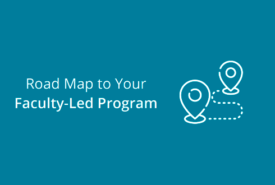
Designing a short-term study abroad program is not a short task, but this overview will help you examine each step of the planning process and what questions to ask yourself along the way.
Defining Program Expectations
When designing a short-term study abroad program, a good rule is to start backwards. Start by defining the program’s expectations and goals and make sure to keep it centered around the student participants. How will the students be enriched educationally and culturally through various avenues during the short-term study abroad program?
Some things to consider should include:
● Student Development
● Learning Outcomes
● Language and Intercultural Development
● Interpersonal Development
● Environmental and Cultural Responsibility
Type of Program
What kind of program should you design? You have your goals and expectations determined so now is a good time to begin the planning process by answering the following questions:
- What type of students are expected to enroll in this program?
- Is it specialized for one specific major or is it open to all undergraduates?
Things to consider would be including a major that might not have time to study abroad during a full semester but would flourish in a short-term study abroad programing like a STEM major. Or if you are worried about participation and interest within a smaller major, try creating a dual program with two complimentary majors.
- Is there a language barrier at the destination of study?
- Will students need previous language courses before they can apply for the program or will language classes be provided during the stay?
If a language component is a major aspect of the program, previous study is beneficial to truly developing language skills. During a short-term study abroad program, students can be enriched in their language development by implementing a partner project with students at a host country university.
- What are the minimum requirements for students who apply to the program?
Things to consider would be their GPA, good standing or a recommendation from a professor, and their year in school (such as programs only open to students who are in their 2nd year or higher).
Program Planning
Designing a short-term study abroad program includes deciding on an itinerary, accommodation, and transportation. There is no set in stone perfect destination or length of time, because it all depends on a multitude of factors like the size of the group, content studied, and budgetary restrictions.
To get the most value out of your study abroad program here are some tips:
● Include trending destinations to increase student’s excitement about the program and participation.
● If your itinerary includes multiple stops, plan overnight bus transportation to save on accommodation and maximize daylight hours.
● Locate college campuses abroad to determine if they have extra summer housing options for traveling students.
● Include a weekend excursion close to one of the study sites to give students free time to explore and keep costs low instead of having students plan private travel.
● Consider working with a tour provider to help streamline the planning process, getting valuable advice and expertise as well as discounts across the board.
Program Evaluation
Compiling a program evaluation is a crucial step in successfully designing a short-term study abroad program. The earlier completed, the better so that the program can be created to reflect the goals of the evaluation and therefore can be judged accordingly. When thinking about what to evaluate, go back and revisit the goals of the program.
Some ideas include:
What kind of academic instruction was used and how was academic performance assessed?
How was language proficiency improved through instruction and interaction in the host country?
In what ways did students grow intellectually, socially, and globally during the program?
What improvements can be made for future programs?
This is in no way an exhaustive list of the evaluation possibilities, but it is a good foundation to start with. A great program evaluation will be informative, easy to read and complete, and sectioned off into categories. If interested in more ideas, Washington College has a detailed evaluation sheet example.
Orientation
The best practice regarding orientation is to have one session two months before departure and another one on the first day abroad to acclimate students. A successful orientation will go over health, safety, required travel documentation, and an overview of the program.
It may be helpful to have a visual presentation and downloadable content sent to the student’s email. The informative content could include a packing list, information on communication abroad like phone plans and emergency contacts, and helpful phrases in the language of the host country.
Program Development
Road Map To Your Faculty-Led Program

Planning your faculty-led study abroad program and don’t know where to start? As experienced tour providers, we’ve laid out your first three, simple steps that you need to begin thinking about for your program. Download our Road Map to Your Faculty-Led Program to get started today.

